There are four solutions to hide files and folders on Mac, and this table can help you skip to these four methods directly.
| Workable Solutions | Step-by-step Troubleshooting |
|---|---|
| Fix 1. Use Shortcuts to Hide Files and Folders Mac | Locate the files or folders that you wish to hide. You can use Finder on your Mac for easy access...Full steps |
| Fix 2. Hide Files and Folders on Mac with Terminal | Find the Finder option and click on it. Then, select "Applications" from the left side panel...Full steps |
| Fix 3. Hide Files and Folders on Mac with FileVault | Select the Apple icon from the upper-left corner of your screen and click on "System Preferences"...Full steps |
| Fix 4. Hide Files and Folders on Mac to Another Account | Select "System Preferences" from the Apple Menu. Choose the "Users & Groups" option and log in...Full steps |
Why and When to Hide Files and Folders on Mac
As a Mac user, there will be many occasions where you have to save a file that you don't want to be shared with others. It might seem tricky to do this, especially if you are a beginner at using a Mac. But to hide files on a macOS base system is a simple task and can be done quickly in a few steps. Today, we will be discussing step by step how to achieve this with proper instructions and details.
You should hide files and folders on Mac for many reasons. Below mentioned can be a few reasons to hide files on macOS Ventura:
- To protect system files from being accidentally deleted.
- For keeping your files and folders private.
- To avoid leaking and compromising the safety of your data.
The reasons can be any, but with the proper steps, you can hide folders on Mac anytime with just a few quick and easy steps. It is also possible to hide folders using shortcuts and then unhide those files and folders on Mac later. You can also create hidden files on Mac or even hide files on macOS Ventura.
After reading this post, you still need clarification on the whole process. Here's a video from where you can learn how to hide files and folders on Mac.
- 00:37 Open Terminal on Mac.
- 01:41 Use the Mac shortcut to hide files.
- 02:01 Adjust keyboard settings.
Fix 1. How to Use Shortcuts to Hide Files and Folders on Mac
Now, without further delay, let us discuss the various methods in detail. Files getting hacked or corrupted from your device are of low chance if you are a macOS user. It is the most secure operating system. However, that doesn't mean that your files and folders are kept from being exposed to anyone who uses your device.
Personal data is sensitive and is better not to be shared in this time of advancing new inventions and technology.
You can hide or unhide files and folders on Mac in different ways. First, we will discuss the most straightforward method out of all that is to hide files by using simple Mac keyboard shortcuts. This method is very efficient because you can hide and unhide the files using the same shortcuts.
For this method, your macOS should be above the 10.12 version. Otherwise, it won't work, so check beforehand and update to the latest version of macOS. Follow the steps below:
Step 1. Locate the files or folders that you wish to hide. You can use Finder on your Mac for easy access.
Step 2. Press Command+Shift+Period(.) simultaneously to hide the required files. You can press these keys again to unhide the files or folders whenever you want to re-access them.
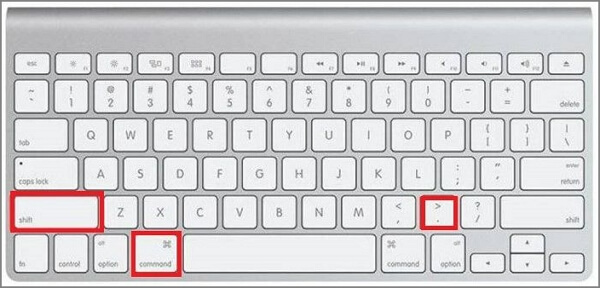
Even though it is easy for anyone to hide files and folders on Mac, it is a standard method known mainly by all Mac users. We suggest you go another way if the files are essential and you don't want anyone to see them.
Fix 2. How to Hide Files and Folders on Mac with Terminal
As we mentioned earlier, using keyboard shortcuts is easy, but it is only sometimes safe. Another method that can be used and is best for hiding sensitive information is by using the Terminal command.
This method might sound complicated, but no need to worry, you need to follow the steps and required commands, and you will be good to go. To hide files and folders on Mac with Mac Terminal, do the following:
Step 1. Find the Finder option and click on it. Then, select "Applications" from the left side panel.
Step 2. Scroll down, select the "Utilities" option, and click on it to open the "Utilities" menu.
Step 3. Double-click on the "Terminal" option and type the following line: chflags hidden.
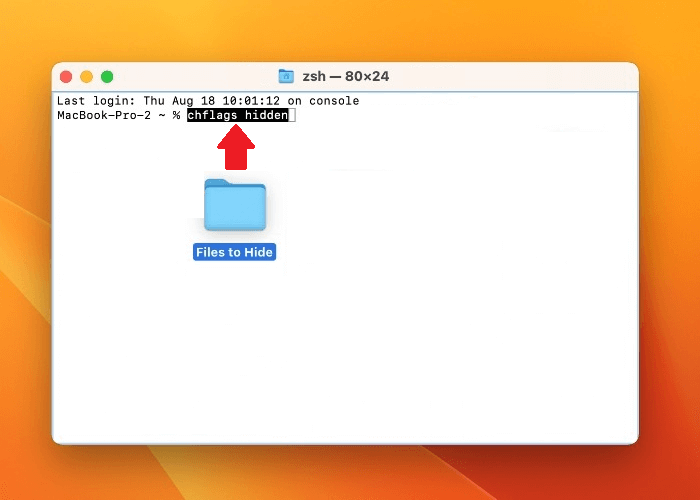
Step 4. Create a new folder and transfer all the files you want to hide to this new folder.
Step 5. Select this folder and drop it into the Terminal window. Hit "Return" to further hide the selected folder.
Fix 3. How to Hide Files and Folders on Mac with FileVault
If you are looking for another safe method with no use of any codes and doesn't seem complicated, then go for hiding files and folders with FileVault. With the help of FileVault, you can turn your hard drive into a knot that gets opened only with a proper username and password given to your admin account. You can also encrypt hard drive on Mac with FileVault.
This program protects your files and folders with encryption and is the best method to hide files and folders on Mac. Let us look at the step-by-step guide for this method.
Step 1. Select the Apple icon from the upper-left corner of your screen and click on "System Preferences".
Step 2. Then, select the "Security & Privacy" option. Next, go to the FileVault tab, which is available next to the "General" tab.
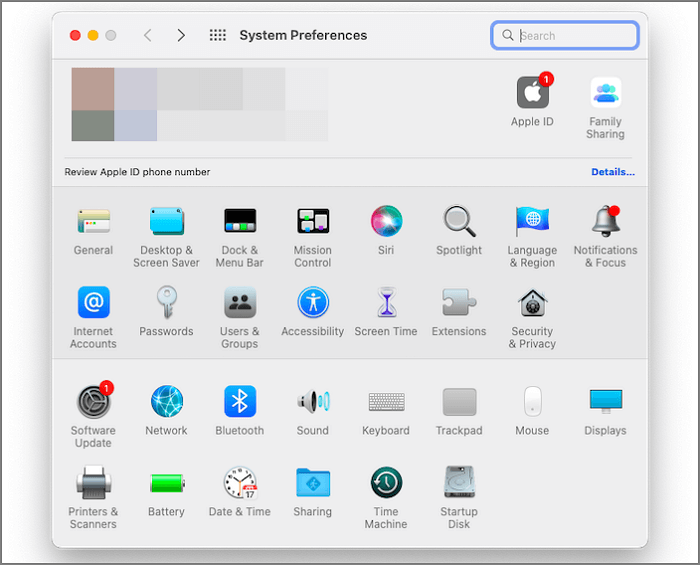
Step 3. Select the padlock icon to make any changes.
Step 4. Turn on the 'FileVault" button.
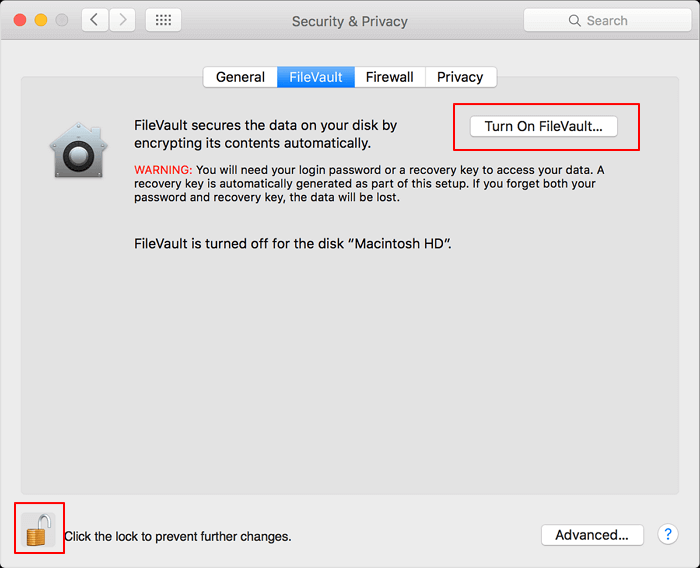
Step 5. Select the recovery method from the net dialog box. You can choose an iCloud or generate a local recovery key in this step.
Note: Choosing a local recovery key would be more advisable because it's comparatively the most secure. Suppose you decide to use the recovery key. In that case, you will go to another dialog box to get a system-generated code. You can save this in a new document, which will be the recovery code you use if you forget the password.
Step 6. Click on continue to finish the entire process. Further, FileVault will start encrypting your files, which might take hours to a few days depending on the data. All the processes will occur in the background so that they won't interrupt your other work.
Fix 4. How to Hide Files and Folders on Mac to Another Account
This method is not very safe, but if none of the above-explained methods are for you, try this. You can hide files and folders by transferring them to another "User’s Account." The steps are simple to follow, so there won't be any confusion.
Step 1. Select "System Preferences" from the Apple Menu.
Step 2. Choose the "Users & Groups" option and log in with all the details required for the process. Then, click on the "+" sign.
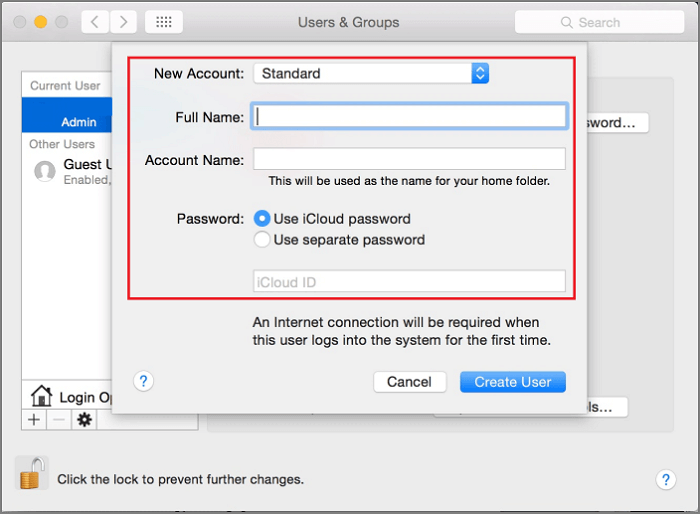
Step 3. You will see a new user window and add all the necessary information. Finally, click on "Create User".
With this method, you can move all the files and folders to be hidden from this new user from the previous one, and no one except you will have access to them. This is another excellent way to hide files and folders on Mac.
Recover Deleted Hidden Files and Folders on Mac with Software
After hiding the necessary files and folders on Mac, you can recover and show hidden files on Mac later using various methods. One such way is by using a recovery data tool. To do this, you can go for EaseUS Data Recovery Wizard for Mac, one of the safest Data Recovery Software for Mac users.
EaseUS Data Recovery Wizard for Mac helps users with any data lost by accident or emptying Trash Mac without limits. The tool is powerful and reliable as it recovers any required file irrespective of size. You can quickly recover deleted files Mac from multiple devices without any difficulties. It is also easy for beginners to use and automatically restores all the recovered data to the cloud storage. Getting the software is easy by choosing any plans from their official website. You can also do a free trial before confirming your final decision. It is a great way to test this software as it has a 30-day money-back guarantee.
Follow the steps below to recover deleted hidden files and folders on Mac:
Step 1. Select the location and scan
Launch EaseUS Data Recovery Wizard for Mac and choose the disk where you lost data. Then, click "Search for lost files" to start scanning.

Step 2. Filter and preview lost files
After the scan, use the file format filter on the left or upper right corner to find the deleted files you need.

Step 3. Recover lost data or files
You can double-click a file to preview its content, or choose multiple files to recover them at once. Click "Recover" to restore the lost data to a local or cloud drive.

Summary
Hiding the files and folders on Mac is essential for many of us, so it is not unusual. There is always one reason or another to protect our data from being exposed to the outside world.
Securing such sensitive data and files is essential. To do this, you can always try any of the methods mentioned and discussed here.
We also recommend using EaseUS Data Recovery Wizard for Mac to gain the best results if you want to recover some of your files. Lastly, we hope this post was helpful, and next time, you will be able to hide files and folders on your Mac without any struggle.
Hide Files and Folders on Mac FAQs
Now, we will look into some common questions about hiding files on Mac, along with their answers.
1. How to recover and show hidden files on Mac?
There are many methods by which you can recover and show hidden files on Mac. The simplest way is to use the keyboard shortcuts method. Use the shortcut, Command+Shift+Period(.) to not only hide your required files and folders but also to unhide them whenever necessary. You can also use data recovery software such as EaseUS Data Recovery Wizard for Mac to recover any lost data without concern about their file sizes.
2. How do I permanently hide a folder on Mac?
You can permanently hide a file or folder on your Mac using various methods, whichever seems suitable and manageable. The simple way is using the keyboard shortcut method. But the shortcut method and the method of using another User Account are only partially safe. In that case, using the Terminal command or FileVault is a great way to tackle this situation.
3. How to hide and unhide files on Mac with Terminal?
One of the best and most valuable methods to hide and unhide files on your Mac is with the help of the Terminal command. This particular method sounds more complicated than the rest due to the use of codes by the users to hide the files.
You can follow this method by choosing the Terminal option from the Utilities Menu and typing in chflags hidden to create a new folder and transfer all the files that need to be hidden. You can also unhide the files doing a similar method without further continuing.
4. Why did my hidden files on Mac disappear?
This may cause by the files that might have accidentally been lost or deleted during any process, or you cannot recover them due to a password. There is no need to panic as you can recover files and folders quickly with the Data Recovery Software from EaseUS. You will get back all your lost files without any issues.
Was This Page Helpful?
Daisy is the Senior editor of the writing team for EaseUS. She has been working at EaseUS for over ten years, starting as a technical writer and moving on to being a team leader of the content group. As a professional author for over ten years, she writes a lot to help people overcome their tech troubles.
Dany is an editor of EaseUS who lives and works in Chengdu, China. She focuses on writing articles about data recovery on Mac devices and PCs. She is devoted to improving her writing skills and enriching her professional knowledge. Dany also enjoys reading detective novels in her spare time.
-
EaseUS Data Recovery Wizard is a powerful system recovery software, designed to enable you to recover files you’ve deleted accidentally, potentially lost to malware or an entire hard drive partition.
Read More -
EaseUS Data Recovery Wizard is the best we have seen. It's far from perfect, partly because today's advanced disk technology makes data-recovery more difficult than it was with the simpler technology of the past.
Read More -
EaseUS Data Recovery Wizard Pro has a reputation as one of the best data recovery software programs on the market. It comes with a selection of advanced features, including partition recovery, formatted drive restoration, and corrupted file repair.
Read More
Related Articles
-
4 Ways to Fix SanDisk Extreme Portable SSD Not Mounting Mac
![author icon]() Brithny/Dec 12, 2025
Brithny/Dec 12, 2025 -
Mount Failed with 66: Volume Could Not Be Mounted - 3 Ways Here!
![author icon]() Brithny/Dec 12, 2025
Brithny/Dec 12, 2025 -
How to Mount a Seagate Hard Drive on a Mac [Wihout Data Loss]
![author icon]() Brithny/Dec 12, 2025
Brithny/Dec 12, 2025 -
Office 365 Outlook Data File Location on Mac: How to Access Outlook Files on Your Mac
![author icon]() Brithny/Dec 12, 2025
Brithny/Dec 12, 2025